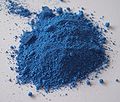- Cobalt blue
-
Cobalt blue is a cool, slightly desaturated blue color, historically made using cobalt salts of alumina. It is used in certain ceramics (historically, especially Chinese porcelain) and painting; the different cobalt pigment smalt, based on silica, is more often used directly in tinted transparent glasses. The pigment is extraordinarily stable.
Chemically, cobalt blue is a cobalt(II) oxide-aluminium oxide, or cobalt(II) aluminate, CoAl2O4. The compound is made by sintering the stoichiometric mixture of finely ground CoO and Al2O3 (alumina) at 1200°C.
Cobalt blue in impure form had long been used in Chinese porcelain,[1] but was independently discovered as a pure alumina-based pigment by Louis Jacques Thénard, in 1802.[2] Commercial production began in France in 1807. The first recorded use of cobalt blue as a color name in English was in 1777.[3] The leading world manufacturer of cobalt blue in the 19th century was Blaafarveværket ("blue-color works," in Dano-Norwegian) in Norway, led by Benjamin Wegner. Germany was also famous for production- especially the Blaufarbenwerke ("blue-color works," in German) of Schneeburg. The dye is not to be confused with Prussian blue, which is an intensely-blue pigment based on iron and cyanide, that contains no cobalt.
Contents
Cobalt blue in human culture
- John Varley suggested cobalt blue as a good substitution for ultramarine blue for painting skies.
- Maxfield Parrish, famous partly for the intensity of his skyscapes, used cobalt blue, and cobalt blue is sometimes called Parrish blue as a result.
- Cobalt blue was the primary blue pigment used in Chinese blue and white porcelain for centuries, beginning in the late 8th or early 9th century[4].
- Because of its chemical stability in the presence of alkali, cobalt blue is used as a pigment in blue concrete.
Glassmaking
- The blue seen on many glassware pieces is cobalt blue, and it is used widely by artists in many other fields.
- Cobalt glass almost perfectly filters out the bright yellow emission of ionized sodium, common in most flames (as even the most trace amount of it is very overpowering).
- "Cobalt Blue" is used as a filter used in ophthalmoscopes, and is used to illuminate the cornea of the eye following application of fluorescein dye which is used to detect corneal ulcers and scratches.
Sports
- Major League Soccer's Kansas City Wizards have had cobalt blue as the secondary color of its home uniforms since 2008.[5]
Vexilology
- Several countries, like the Netherlands and Romania, have cobalt blue as one of three shades of their tricolour.
Toxicity
Cobalt blue is toxic when inhaled or ingested. Potters who fail to take adequate precautions when using cobalt blue may succumb to cobalt poisoning.
See also
References
- ^ Kerr, Rose; Wood, Nigel (2004), Science and Civilisation in China Volume 5. Part 12, Ceramic Technology, Cambridge: Cambridge University Press, pp. 658-692, ISBN 0-521-83833-9.
- ^ Gehlen, A.F. (1803). "Ueber die Bereitung einer blauen Farbe aus Kobalt, die eben so schön ist wie Ultramarin. Vom Bürger Thenard". Neues allgemeines Journal der Chemie, Band 2 (H. Frölich.). http://books.google.de/books?id=UGsMAQAAIAAJ&pg=RA1-PA506. (German translation from Thénard, L.J. (1803, (Brumaire, XII)), "Considérations générales sur les couleurs, suivies d'un procédé pour préparer une couleur bleue aussi belle que l'outremer", Journal des Mines 86: 128-136, http://annales.ensmp.fr/articles/1803-1804-1/71-75.pdf.
- ^ Maerz and Paul A Dictionary of Color New York:1930 McGraw-Hill Page 91; Color Sample of Cobalt Blue: Page 131 Plate 34 Color Sample L7
- ^ "Chinese visual arts » Stylistic and historical development, 1206–1912 » Yüan dynasty (1206–1368) » Ceramics." Encyclopedia Britannica Online. Accessed 14 May 2009.
- ^ "Wizards unveil new look for '08 season," Kansas City Wizards Media Relations, January 20, 2008.
External links
- "History of Cobalt blue". Pigments through the Ages. WebExhibits. http://webexhibits.org/pigments/indiv/history/coblue.html.
Shades of blueAir Force blue Alice blue Azure Baby blue Bleu de France Blue Bondi blue Brandeis blue Cambridge Blue Carolina blue Celeste Cerulean Cobalt blue Columbia blue Cornflower blue Cyan Dark blue Deep sky blue Dodger blue Duke blue Egyptian blue Electric blue Eton blue Federal blue Glaucous Electric indigo International Klein Blue Iris Light blue Majorelle Blue Maya blue Midnight blue Navy blue Non-photo blue Palatinate blue Periwinkle Persian blue Phthalo blue Powder blue Prussian blue Royal blue Sapphire Sky blue Steel blue Teal Tiffany Blue True Blue Tufts Blue Turquoise UCLA Blue Ultramarine Yale Blue The samples shown above are only indicative. Categories:- Inorganic pigments
- Cobalt compounds
- French inventions
- Shades of blue
- Color stubs
Wikimedia Foundation. 2010.


